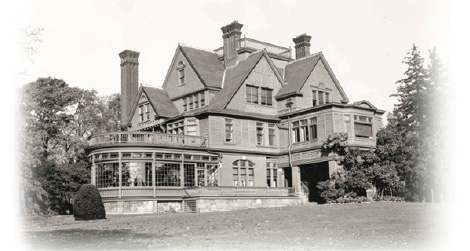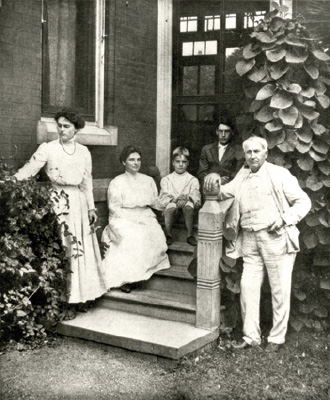Chapter Three
Edison, Family Man

Glenmont, the estate that Edison purchased for his family in West Orange, NJ.
At age 22, Edison was living in New York City, with no place to live and no job. But his experiments with telegraph technology had given him a good reputation with people in the industry. Through these contacts he was able to meet Dr. S.S. Laws. Laws had invented his own version of the stock ticker, and he was interested enough in Edison to offer him a place to stay and eventually a job. Soon Edison started his own business, selling and repairing all kinds of telegraph equipment. He opened his first workshop in Newark, New Jersey.
Edison’s personal life was changing, too. In 1871, on Christmas Day, he married Mary Stilwell. But married life did not change Edison’s habits. He still kept long hours in his laboratory and factory, often sleeping on a cot there, and was rarely home with his wife. In 1873, Edison and Mary had their first child, Marion. But Edison was still working hard to perfect his new telegraph technology and gave little time to his family. Mary became accustomed to raising her daughter mostly alone. It was at this time that the Edisons moved to a new house in Menlo Park, NJ. Edison constructed a laboratory nearby, which made it possible for him to spend even more time working on his inventions.
Edison apparently did feel guilty about how little time he spent with his family, but he was also a compulsive worker and couldn’t help himself. He was usually thinking about more than one idea at a time, and was never satisfied until he had worked out an idea to the point where he felt satisfied with it. Despite his promises to himself that he’d spend more time with his family, he was unable to tear himself away from his work to actually follow through. Mary gave birth to a son, Thomas Jr. in 1876, and another child, William, in 1878, but continued to do most of the parenting on her own.
Marion and Thomas, having been born at the time when Edison was working with his telegraph ideas, were nicknamed “Dot” and “Dash,” after the marks that were left by a telegraph machine. Once she was old enough, Dot could run in and out of her father’s lab, but Mary was forced to stay home—first with Thomas Jr. and then William—and felt more and more isolated from her husband. Mary’s loneliness, on top of her health problems, finally resulted in her death in 1884, at the age of only 29.
Suddenly Edison was alone, with three children to care for. Yet he was also still completely consumed by his inventions. He was now working on the electric light bulb and bringing electricity to New York City. But he was missing the sense of stability that a family provided—even though he never spent much time at home.

Edison and his family in 1907.
In 1884, Edison met Mina Miller, the woman who would become his second wife. They would marry two years later. Mina would give birth to three children, Madeline, Charles and Theodore. While Edison continued to spend more time in his lab than at home, he was very happy with his new wife, saying, “Mina Miller Edison is the sweetest little woman who ever bestowed love on a miserable homely good-for-nothing male.” Even though Edison also once said to Mina, “You and the children and the Laboratory is all my life,” as before, it seemed like the laboratory really came first in his attentions.
Edison’s children were eventually sent to private boarding schools and were frequently homesick and unhappy. Even though Edison did not spend much time with them when they were young, he was often critical of his children. Later in life, his daughter Marion would be estranged from him, even though she was once his best companion.
Mina did her best as the only parent making decisions about her children’s upbringing. She tried to adapt to Edison’s eccentric behavior. She also entertained many of the famous guests who started to come to the Menlo Park house once Edison’s fame as an inventor brought him worldwide recognition.
Regardless of what was taking place in his personal life, Edison was well on his way to becoming the famous inventor we remember today. But what had it taken for him to reach that status? It was simple: a place to work.